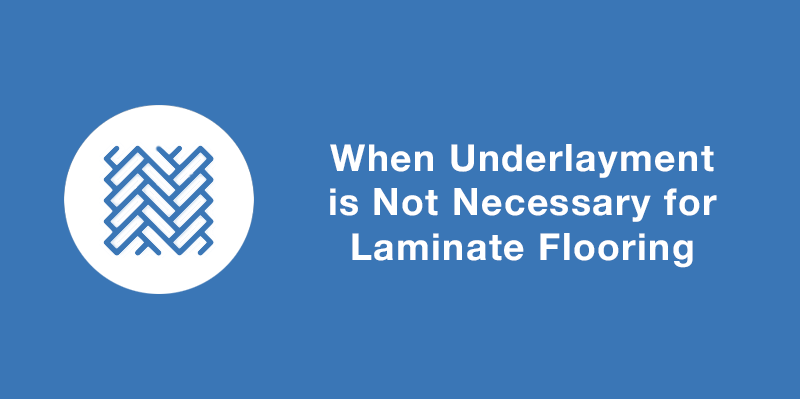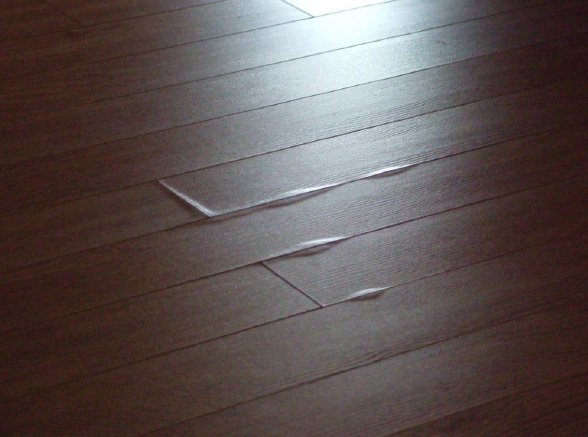When Underlayment is Not Necessary for Laminate Flooring

Re-doing your flooring is a big undertaking, especially for large rooms or your entire home. It takes a considerable amount of time, dedication, and, of course, cash, making it imperative that you follow the old adage (both figuratively and literally, depending on your flooring choice) to cut once and measure twice. Often neither cheap nor easy, you should get exactly the floor you what you want and do it right the first time, saving you from having to do it all over again just a couple of years down the road. This is why it is important to know when underlayment is not necessary for laminate flooring.
For laminate flooring, opting for underlayment is typically encouraged. After all, you really do get several benefits from using the specialized padding. Extra stability and support, noise reduction, cushioning, improved plank laying, and locking system support – all good things if you want your floor to last (and generally be at its best). But what people don’t tell you is that there are a few situations where you can get by without using underlayment. Here are the main ones where underlayment is more a nicety than a true necessity.
Subfloors are in Good Shape
Out of all the items on this list, this is perhaps one of the best reasons to skimp on the underlayment. Why? Well, underlayment is handy for a lot of things, but it’s most crucial for stability. Not including houses that are pretty newly developed or were made with exceptionally great materials/attention to detail, most of our subfloors aren’t flawless. They’ll usually have minor imperfections and slight variations, which can seriously affect the smoothness of any flooring laid over them and impact the connection between the laminate planks.
That’s bad regardless but can only lead to more issues as the seasons and years pass by. Underlayment’s used to nix these before they ever happen as it provides a perfect, solid base for your flooring, free from dents, rips, and the wear of time. A nice dense felt underlayment like QuietWalk is excellent for covering subfloor imperfections. But if you don’t have these or the others factors mentioned next to contend with, underlayment may be optional for you.
Moisture Won’t Be a Problem
Subfloor conditions will significantly impact whether laminate underlayment is essential or not. There are other factors to consider, too, however. Moisture is especially important among these. Underlayment is basically a must-have for areas that tend to be wetter and more prone to humidity because this also increases the amount of moisture in your subfloors. Without underlayment to add a layer between these damp subfloors and the surface flooring, your laminate can quickly become wet, warped, and mildewy, harming its overall integrity. Moisture over time can also break down floor adhesive which causes the floor to start warping.

Not everyone lives in a particularly humid environment, though. Places like Arizona, Nevada, and Utah are significantly drier and hotter with ground that reflects that, meaning that moisture is unlikely to be any major concern. Happen to be among the lucky ranks who live here? Underlayment won’t be nearly as necessary to keep your laminate looking and functioning at its absolute best.
You Don’t Mind a Little Noise
Protection from subfloor imperfections and moisture are both two primary reasons underlayment is a smart choice. But it does have its other perks, too. For example, since it functions as padding between surface and subfloors, much of the noise you’d expect is absorbed, helping the pitter-patter of little (or sometimes not-so-little paws and the loud running of growing rugrats come down to a much more manageable volume. This makes the stuff ideal for busy growing families. Kids and pets can run around, parents can do all their laundry and work, and guests can come and go as needed without serious disturbance.
Yet, that’s not a major bonus for everyone. Some folks have less foot traffic in the house or simply tolerate it better. In these cases, underlayment is definitely way less attractive, and that’s totally fair. We wouldn’t recommend passing on it just because of this, but if you’re already checking off other points we’re talking about, you’re pretty safe to spend your hard-earned cash elsewhere.
Budget is a Big Concern
While on the subject of cash, we’d be remiss not to talk about budget influence here. As we’ve fully admitted, using underlayment brings plenty of benefits to your flooring project. However, it comes at a cost – i.e., though less than flooring, it is an added expense. Laminate and underlayment are mid-cost ranged flooring combos available these days, adding up to a higher price tag than you might be looking for. Some people doing reno might be willing and able to eat those additional costs, but what if you’re already on a tight budget? You could skip it or consider a more affordable foam underlayment.
Underlayment will get you the best results possible, but as with any project, you must have your priorities sorted out and constantly keep them in mind as you move forward. What’s most critical to you? Do you need to keep your immediate costs down but are okay potentially spending down the line for repairs? Are you good on money right now and need to ensure future replacement won’t be needed? Is comfort and sound reduction the main focus, or are you willing to pass on it for easy, cheaper installation? How much are you ready to spend, anyways? Answer these honestly, balance your priorities, and the question of laminate underlayment or not will be easy as can be.
With that being said, if you don’t have all three requirements listed above, underlayment is still highly recommended. Moisture issues and uneven subfloors can result in laminate floor failure, costing you far more in repair costs than installing an underlayment.
Underlayment Comes Pre-Attached
Although there are pad-attached laminate planks out there, you may feel like you’re getting a better deal, but the cost of the attached underlayment is worked into the floor price and quality.
Here is a segment from the carpet captain’s blog, “Laminate Underlayment Guide”. “Since underlayment is an important part of the installation, I usually like my underlayment separate just because I can be more choosy on the type and specifications. You do get a little more convenience with having attached pad, but underlayment is easy to install.”
A separate underlayment will still provide plenty of benefits for anyone who is already set on pad-attached laminate flooring. QuietWalk’s compression resistance exceeds the requirement for pre-attached flooring that is greater than 29 psi @50% per ASTM D1667. The high compression resistance assures that the underlayment will not contribute to floor decoupling.
Conclusion
Underlayment’s great, but if you’re lucky enough to have a dry climate, spotless subfloors, and little need for noise control, it isn’t a necessity. If you have all the optimal conditions and don’t want to spend the extra money for additional benefits, you might as well just lay down your laminate without it. You’ll save on material expenses. This can be helpful in the short term, but the floor’s longevity will be an added risk. If you’re like most of us, you won’t have the fortunate circumstances to skip underlayment. Don’t worry, we got you covered; our underlayment selector tool will help you find the perfect underlayment for your laminate flooring!
Join Our Newsletter
You are about to install your new flooring. As you lay the first plank you realize that
